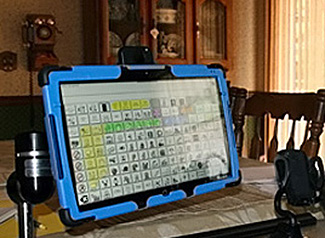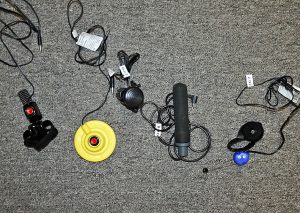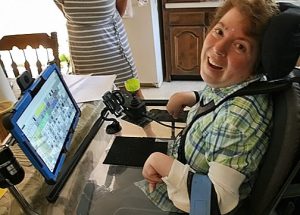In this space last week, we presented our story of Tess C. She used her augmentative and alternative communication (AAC) to share her delightful sense of humor. Tess’s cerebral palsy has left her unable to speak. However one certainly cannot say she is “non-communicative.” In fact, with the help of her Accent 1400, coupled with a NuPoint head-tracking system, she can communicate with astonishing clarity. Both products are from the Prentke-Romich Company (PRC).

Accent 1400 enables people with a wide range of disabilities to communicate and express themselves.
The Accent 1400 et alia
The Accent line comprises speech-generating AAC devices from PRC. The main the objectives of the Accent 1400 and its smaller brothers is to enable people with motor disabilities and speech impairments to communicate. Users with cerebral palsy (CP), such as Tess, are the most common customers. Depending on the type of CP they have, these individuals have any combination of stiff muscles, poor coordination, weak muscles, and tremors. Among most individuals with CP, these fine- and gross-motor impairments affect speech. AAC devices help them overcome these communication hurdles. Even those who have intellectual disabilities benefit.
Many, if not most, individuals with autism have very good to excellent visual-processing skills, even those who cannot express themselves verbally can benefit a great deal from AAC. Children with autism are adept at learning to use symbols than are most others; they do not doubt the associations, analogies, and metaphors the picture icons represent. Often, when children with autism act out, it is a result of frustration to control their voice communication or their surroundings. AAC helps with former, enabling these individuals to express themselves.
PRC also claims that AAC devices, such as the Accent, enable people with Rett syndrome to express themselves and create and enhance cognition, both of which are instrumental in finding and embracing their individuality.
Other people who can benefit from AAC are those with Down syndrome, apraxia, aphasia, traumatic brain injury, or an intellectual disability. With its 14-inch (diagonal) screen, the Accent 1400 is the largest of the line. PRC recommends the 1400 for persons with complex access needs or simply want larger icons.
Important Accessories
PRC offers a host of accessories that enable access to the Accent, including the NuEye eye-gaze tracking system and NuPoint head-tracking system. Both are highly effective among individuals whose severe physical disabilities do not allow them to use a keyboard and mouse or even a large switch or touchscreen.
-

Accent works with many input devices, such as these switches, along with head-pointing and eye tracking systems.
The NuEye eye-tracking device enables the user to use eye movements to control icons and words on the Accent screen.
- The NuPoint head-pointing device contains optical sensors that work with a small reflective dot the user wears on his or her head. NuPoint tracks precise head movement through which the individual accesses icons and words on the Access screen. It is, in effect, a wireless mouse. Tess uses the NuPoint with considerable success.
Other Accent users can gain access through various types of button switches activated by hand, head, or any other body part with which has reasonable motor control. A single switch can be used; two switches allow for separate scanning and key selection. In addition, the Accent works with various types of wireless joystick and other forms of mouse control.
Different Languages for Different Needs

Tess C. shows off the reflective dot on her forehead, part of the NuPoint system.
In addition to hardware described, accessibility to the Accent line is enhanced by a wealth of software options. The multiple language systems are geared toward a wide range of disabilities and individual strengths and abilities. The choice of vocabulary options for the Accent include Unity with LAMP Words for Life (in English and Spanish), CoreScanne, and WordCore. Other available vocabulary options include Essence for literate adults and WordPower. Behind the Accent 1400 is NuVoice software from PRC.
The Accent 1400 helps people like Tess express what they know and feel. It also enables others to understand all they can do.
Accent – Accessibility for People with Many Disabilities


